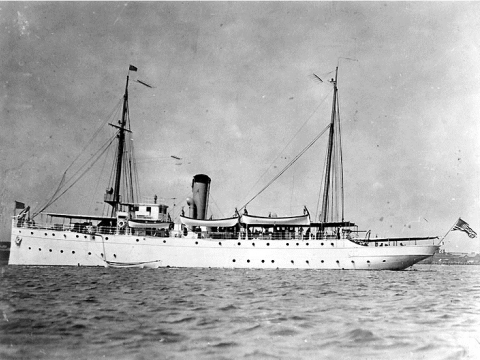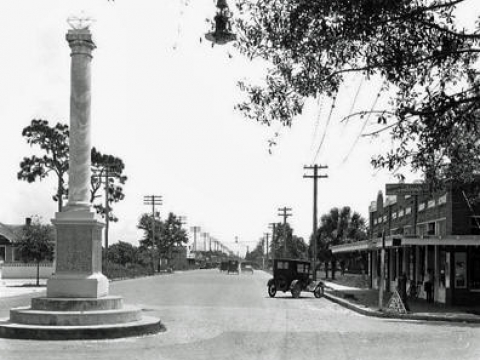Post 5 Tampa, Florida
- Home
- Post 5 Tampa, Florida
Post 5
Tampa, Florida
About This Post
Post Namesake
U.S.S. Tampa and her Legacy: The Coast Guard Cutter TAMPA had its strongest ties with the City of Tampa, Florida. Perhaps it was significant that the vessel was launched during Tampa's festival month of February. At that time, however, there was nothing to indicate the strong bonds that were to grow between the ship and the city. Launched at Newport News, Virginia on February 10, 1912, the vessel was named MIAMI and sponsored by Miss Bernes Richardson. On April 27th she made her trial trip off Hampton Roads, and on May 8th was accepted by the government. Two hundred and fifty-thousand dollars was paid the Newport News Shipping and Dry Dock Company for this vessel, which dispersed 1,181 tons, was 190 feet long and had a 32' 6" beam. On August 19th she was commissioned into the Revenue Cutter Service at Arundel Cove, Maryland.
Less than a year after launching, her friendship with the city of Tampa had begun. She was ordered to Key West on October 21st to take station, and on February 4, 1913 she participated in the Mardi Gras in Tampa, Florida.
Meanwhile, on April 14, 1912, shortly before the MIAMI's trial run, the TITANIC struck an iceberg in the North Atlantic and sank with 1,517 persons aboard. There arose a universal demand for a patrol of the ice zone to warn passing vessels of the day-to-day dangers during the iceberg season. Two Navy scout cruisers performed this patrol for the Revenue Cutter Service. On May 28, 1913, the MIAMI was ordered to New York, and from there to Halifax, Nova Scotia, where she and the cutter SENECA were to base while performing patrol and observation of the icebergs.
On July 30th, her ice patrol completed, the MIAMI arrived back in Key West to resume station. The following February she was again in Tampa for the Gasparilla Carnival. May and June saw her back on ice patrol with the SENECA. This same pattern was repeated the following year, 1915. On January 28, 1915, the MIAMI and the rest of the Revenue Cutter Service, along with the Life Saving Service, were amalgamated into the present-day Coast Guard.
On February 1, 1916, three days before the Gasparilla Carnival and the South Florida Fair in Tampa, the name MIAMI was changed to TAMPA. Again that year she made the ice patrol then returned to Key West.
1917 was very eventful to the crew of TAMPA. The South Florida Fair and the Gasparilla Carnival/Tampa was the greatest yet, lasting nine days from February 2nd through the 10th. With four days to recuperate from the gala affair, they went on to patrol the Annual Boat Regatta at Miami from the 15th through the 17th of February. On March 27th and 28th they patrolled the races of the St. Petersburg Yacht Club in St. Petersburg, Florida.
There was a shadow over the spring gaiety of 1917, however. February 2nd, opening day of the Fair and Carnival in Tampa, was the day the United States broke off diplomatic relations with Germany. Perhaps the men of the TAMPA sensed that this would be the last celebration with the citizens of Tampa, Florida. On April 6th the United States declared war with Germany, and immediately the TAMPA and other Coast Guard Cutters were transferred to the Navy. After being fitted with four three-inch, 50-caliber guns, the TAMPA left for European waters on September 15th.
Based in Gibraltar, the TAMPA, SENECA (her companion ship of ice patrols), YAMACRAW, OSSIPEE, ALGONQUIN and MANNING made up Squadron 2 of Division 6 of the Atlantic Fleet Patrol Forces. Their mission was to protect convoys from submarine attacks. In the little more than a year left to her, the TAMPA escorted 18 convoys, comprising a total of 350 vessels, through the submarine-infested waters from Gibraltar to Britain. In spite of spending more than fifty percent of her time at sea and steaming an average of 3,566 miles a month, her one request for repairs had been two minor items.
Rear Admiral Niblack, commander of the U.S. Naval Force on Gibraltar, commended Captain Charles Satterlee of the TAMPA in a letter on September 15th, 1918:
"This excellent record," wrote Niblack, "is an evidence of a high state of efficiency and excellent ship's spirit and an organization capable of keeping the vessel in service with a minimum of shore assistance. The squadron commander takes great pleasure in congratulating the commanding officer, officers and crew on the record they have made." The TAMPA's logs reflect this high morale, in spite of rather grueling duty. There were swimming parties and baseball parties at Gibraltar, and an occasional liberty in London.
On September 26, 1918, the day of the France-American attack in Argonne, the TAMPA was escorting a convoy to Milford Haven, Wales. The evening found them in the Bristol Channel. The night was black and a slight rain was falling, being driven before a heavy wind. The TAMPA, perhaps detecting some sign of a submarine, darted out ahead of the convoy. At 8:45 p.m., a loud explosion was heard by people aboard the other ships, and later when they arrived in port, the TAMPA was missing. A search was started by the U.S. destroyers and British patrol craft, but all they found was a few pieces of wreckage and two unidentifiable bodies in naval uniforms.
The TAMPA was believed to have been torpedoed, and later a man from a captured U-Boat, the U-53, reported that they had sunk a ship of the TAMPA's description at that time and place.
When the TAMPA sunk there were no survivors. Three Coast Guardsmen, four Navy men, a captain and 10 seamen of the Royal British Navy, and five civil employees -- a total of 131 persons -- lost their lives. This loss was the greatest single casualty incurred by any Navy unit as a result of known enemy action, and because of it the Coast Guard suffered the greatest loss, in proportion to its size, of any armed service in the War.
Admiral William S. Sims, a senior naval officer on duty in Great Britain, received the following letter from the Lord of the British Admiralty:
"Their Lordships desire me to express their deep regret at the loss of the USS TAMPA. Her record since she has been employed in the European waters as an ocean escort to no less than 18 convoys from Gibraltar, comprising of 350 vessels, with a loss of only two ships through enemy action. The commanders of the convoys have recognized the ability with which the TAMPA carried out the duties of the ocean escort. Appreciation of the good work done by the USS TAMPA may be some consolation to those left behind and Their Lordships would be glad if this could be conveyed to those concerned."
Eighty-one years after the ultimate sacrifice, the descendants of the men who perished received their Purple Hearts in a ceremony at Arlington National Cemetery, held on Veterans Day, November 11th, 1999. Representatives from the American Legion USS TAMPA Post 5, of Tampa, Florida, were in attendance for the special presentation ceremony. Secretary of Transportation Rodney Slater and the Commandant of the United States Coast Guard presented the medals, in conjunction with the annual Veterans Day Wreath-Laying Ceremony at Arlington.
The American Legion USS TAMPA Post 5 has a Memorial Window located for the Tampians and the USS TAMPA crew who lost their lives. This beautiful, varicolored window first adorned the Ladies' Auxiliary room at the USS TAMPA Post in its first location at 513 Bay Street in Tampa, Florida. Built by the Works Project Administration (WPA) during World War I, the window now has a permanent home at 3810 Kennedy Boulevard in Tampa.
The window is five feet wide, the lower section is seven feet tall, with the arched portion above three feet high. Ranged around the Great Seal of The American Legion are the names of the 115 men (including the 24 Tampians) who perished with the sinking of the Coast Guard Cutter, the USS TAMPA, on September 26th, 1918 in the Bristol Channel off the coast of Wales.
What Makes this Post Unique
Post 5 has the only American Legion Cemetery in the world. Post 5 bought the 2-acre land in the 1920s, with auxiliary member Mrs. O.N. Bie leading the charge. According to legion lore, Mrs. Bie couldn't stomach the notion of a homeless World War I veteran being buried in a pauper's grave. At the time, the cemetery was on the outskirts of town. Now, it's near one of Tampa's busiest intersections, adjoining the even smaller Hopewell Church Cemetery. Lindell Motors is on one side, a strip mall on the other. The bone-white tombstones march toward a line of oaks. Still, this is sacred ground. Protected ground. Care of the Tampa cemetery falls to the American Legion Cemetery Corp., a group founded in the 1970s. The corporation board has six members - three from Post 5 and three from Auxiliary Unit 5.
Share:
HISTORY
1910
USS Tampa Receives Temporary Charter
Jun 2, 1919
USS Tampa Receives Temporary Charter
USS Tampa Receives Temporary Charter
1920
USS Tampa Receives Permanent Charter
Sep 13, 1920
USS Tampa Receives Permanent Charter
USS Tampa Receives Permanent Charter
1950
USS Tampa Receives Supplemental Charter
May 28, 1953
USS Tampa Receives Supplemental Charter
USS Tampa Receives Supplemental Charter
2010
Bay News Nine Story
Mar 4, 2014
Heather Tabman who owns "heathersillusions" for painting murals has been painting two very amazing murals on Post 5's front entrance side walls. One is a WWI soldier standing in a Poppy Field (Flander's Field) and the other is a bald eagle with a flag. Absolutely beautiful. http://www.baynews9.com/content/news/baynews9/news/article.html/content/news/articles/bn9/2014/3/4/patriotic_mural_in_w.html
Heather Tabman who owns "heathersillusions" for painting murals has been painting two very amazing murals on Post 5's front entrance side walls. One is a WWI soldier standing in a Poppy Field (Flander's Field) and the other is a bald eagle with a flag. Absolutely beautiful. http://www.baynews9.com/content/news/baynews9/news/article.html/content/news/articles/bn9/2014/3/4/patriotic_mural_in_w.html


